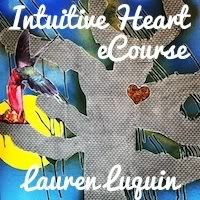
I waited for the top layer to dry - very fast since it was a sweltering hot, sunny day.
Then I flipped the canvas over and and began applying the paint to the back with a big brush, adding water as needed with the brush. This side looks very primary but I will paint over it later and this canvas will become double-sided - I can rotate it on a whim :)
I chose where I put the big washes of colour on the back because I wanted it to bleed through in specific places on the front. For example I wanted the weeds to be greenish.
With this technique, what happens is that the paint on the front blocks colour from bleeding through from the back. The paint from the back only will bleed through onto any remaining parts of canvas that are still raw. It ended up having a far cooler effect than I had expected and I'm really excited about it :-)
One of the parts of this piece that I love most is the way the colour gradation shows through in the three diagonal lines in the corner:
I put my second piece of canvas under the piece I was painting part way through - as soon as I saw what cool effects were bleeding through onto the old sheet. I wanted them on the blank canvas instead!
Would I do anything differently if I did this again?
Yes - first of all I would use more than one finger for holding down the spray nozzle! :-)
I also would leave more areas raw, with only sparse splatter on them, because of how much I love the bleeding through effect.













































